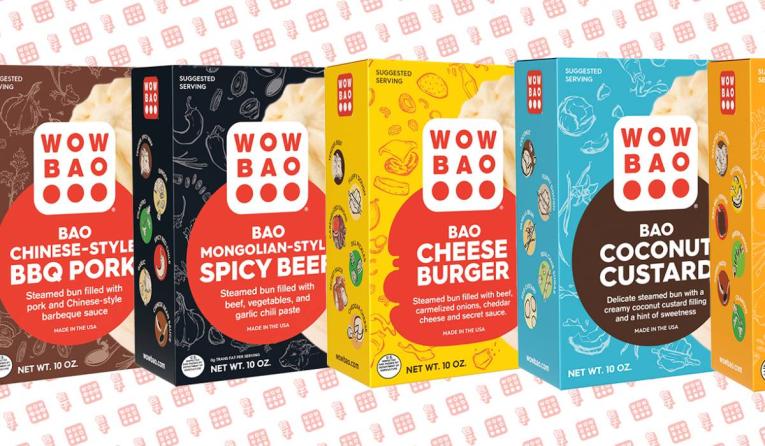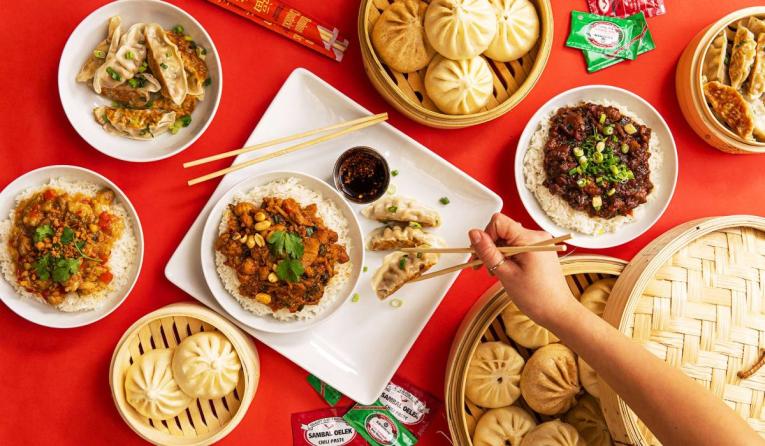Geoff Alexander was starting to get used to hearing he was crazy. He chaired a National Restaurant Association group and not one of the 20 CEOs he asked thought his plan was sane. Then, he headed to a Lettuce Entertain You partner meeting with 70 or so operators who ran restaurants across America. “And they were all like, ‘you’re nuts,’” Alexander says.
But one, Bill Nevruz with Shaw’s Crab House in Schaumburg, Illinois, decided selling baos out of his kitchen to third-party customers might be worth trying. This was January 2020. Within three months, Alexander’s outlandish concept morphed into a lifeline for an industry that suddenly couldn’t open its doors to guests. Wow Bao would enter the kitchens of roughly 170 restaurants from April to December. The following year, it added another 250–300. This past year, Wow Bao surpassed the 700 mark and got into Canada. And if it connects with a deal it’s currently exploring, the brand could cross 1,000 units before this calendar runs its course.
How did this story get here? Alexander has reflected on that question a lot lately as Wow Bao turns 20 years old in August. The brand just struck a CPG deal with Walmart to expand its retail vertical from 1,000 grocery stores to north of 4,000. Wow Bao started the year at 350 and 1,000 sushi counters. It’s likely going to end 2023, Alexander says, at close to 6,000–7,000 CPG locations. It’s gone from one co-packer to five. The company signed a national broker to help grow its CPG and is at about 40 percent of capacity.
“I would say, 100 percent,” Alexander responds, of being taken aback by the journey.
Naturally, the pandemic provided kindling to Wow Bao’s trajectory nobody could have predicted. But to really grasp the brand’s rise, you have to return to the start.
In 1999, Alexander did a tasting for Lettuce Entertain You proprietor Rich Melman. They were presenting the bao as an appetizer for Big Bowl, a concept still in operation today. Melman, who is famous for his filing cabinets stuffed with ideas, placed that one alongside the others.
In the winter of 2002, Chicago’s Water Tower Place on the Magnificent Mile had an opening by its front door. LEYE sold gift cards and was offered the chance to keep it beyond the holiday rush. But there was no venting system. Wow Bao, though, only needed a steamer, which it could do on the side of the building, downstairs through the garage. And so, the first Wow Bao arrived August 22, 2003. It would be another six years, on New Year’s Day 2009, before Alexander took over.
The LEYE partner directing Wow Bao left the company. Bruce Cost, who had worked with Alexander at Big Bowl, brought the idea over. “He said, ‘we’re going to do thousands of these,” Alexander recalls. “It’s going to be the biggest thing ever in Lettuce Entertain You’s history. I had never actually had Wow Bao outside of tasting it four years earlier, but I was like, sure, this sounds exciting. Let’s go do it.”
Alexander admits he had no clue what he agreed to. “I walked into a catastrophe,” he says. “I was sold a lemon car.”
How Alexander fixed Wow Bao would come to define it. The chain went places other restaurants weren’t willing to. It had self-order kiosks and mobile ordering and digital gift cards by 2011. Wow Bao’s iPhone app for online ordering landed in 2010. To put into perspective how infant stages that was, the iPhone 4 had just released with a new feature—FaceTime. It started at $199.
A year before, Wow Bao outfitted a van with a hot holding cabinet and cooler and took its buns on the road. “The Bao-Mobile” was named one of the most influential food trucks in the U.S. by Mobile Cuisine.
Wow Bao, in 2010, opened an ordering kiosk inside what was then U.S. Cellular Field, home of the Chicago White Sox. It brought those to NBA, NHL, NFL, and more MLB stadiums nationwide.

“The more you got the food in people’s hands and educated them on what it was, the faster the acceptance was about it,” Alexander says.
The following year, Wow Bao commissioned a booth at the 100,000 person per day Lollapalooza music festival. Grocery entered the picture in 2012 at Jewel and Sunset Foods. Alexander personally walked up to his local market and pitched the product. The second time he did so, it was the store his wife frequented growing up. Alexander asked the owner to help him earn brownie points with the in-laws.
Wow Bao then became the first LEYE brand to enter an airport in 2014. Six have launched since, with No. 7 headed to Salt Lake City in the fall. Colleges—also a LEYE debut—showed up the next year when Wow Bao partnered with Sodexo to open on the University of Vermont, Kent State, and Indiana State.
“It was all about getting the name out there and the ease of execution and finding partners to work with,” Alexander says.
As noted, when Alexander arrived, Wow Bao had just three brick-and-mortars, and it wasn’t all humming. The original Water Tower unit, at 384 square feet, was busy. State & Lake and Jackson units opened in 2017. The former is still there, but the latter closed in 2018. It boasted a strong lunch business, then died after 1 p.m., Alexander says.
What he had come to understand, however, and would soon unlock the picture materializing today, was Wow Bao’s roadblocks never concerned the food. Melman gave away 50,000 baos in the concept’s first year to get the word out. He wouldn’t have done so, Alexander says, if he didn’t see the vision, too.
“The more you got the food in people’s hands and educated them on what it was, the faster the acceptance was about it,” Alexander says.
With that in mind, Wow Bao got involved with bicycle delivery. It was the third restaurant in Chicago to partner with Uber Eats when the aggregator launched. The company started doing “every charity function” it could find and set tables up to give food away, Alexander says. “It was all about how do I put my food into your hands and you see how great this product is,” he explains. “Do you want to keep working with us? That was the turning point for the brand, more than anything else.”
Valor Equity Partners took a majority stake in Wow Bao in 2017, partnering with LEYE to ignite growth across this multi-channel universe. It included the launch of the cloud kitchen concept September 2017 in L.A. December 2017 marked Wow Bao’s first fully automated front-of-the-house location. Between 2017 and 2018, three more automated units opened.
And that brings us to the present view of Wow Bao most people are familiar with. Jon Shulkin, partner and co-president of Valor, and chairman of Wow Bao, met with Alexander in August 2019 to address one of the emerging sector’s age-old quandary’s—what’s next?
Valor’s PE tentacles reach through a network of brands and geographies. Alexander wondered, why couldn’t Wow Bao sell its products out the back door of multiple brands for third-party delivery? “It was kind of a joke,” he says. “Like, we have all these partners, why can’t they just sell Wow Bao? But it was an aha moment for Jon.”
“I remember thinking, ‘what did I just say and get myself involved in.”
Wow Bao already had national distribution thanks to its nontraditional efforts. It got to work on online training materials and deepened its relationships with third-parties. Soon, Alexander was presenting the notion to peers (by the way, three of those 20 CEOs now work with Wow Bao), which circles back to the opening.
This idea, of renting a brand, so to speak, was something nobody wanted to touch. But then the country shut down and there was nothing to do but delivery. Alexander says Wow Bao focused all its energy on the idea. To refresh, literally one brand had bought in at that point.
Wow Bao’s goal was to make it as streamlined and quick as possible for restaurants, from independents to chains of every ilk, to turn the brand on and evolve stark kitchen capacity into lifeboat revenue.


The brand’s rapid expansion across COVID is something Alexander says will always be difficult to grasp the gravity of. Sitting on his desk is a hero award Wow Bao received for how it helped the industry. “That’s why we call it a dark kitchen, because we brought light to those restaurants,” he says.
The industry isn’t closed off any longer and the virtual brand space, in general, has chopped through headlines predicting its demise, from MrBeast’s square-off to the overall retraction.
Alexander says it’s an overblown projection to say virtual concepts are sunsetting. He believes the segment is in “the second inning of a ballgame.”
“We have this opportunity now to come back and win,” he says. “In any business, you hit hurdles and have to learn from it. This MrBeast thing, to me, that’s operations, not the brand. Do you know anybody outside of MrBeast who has gone from zero to 2,000 in 18 months? It’s unheard of … So to think they’re going to open 2,000 locations in 18 months and there’s not going to be problems is absurd.”
Alexander says operators shouldn’t focus entirely on the negative spin. Instead, “let’s focus on the good that it brought to the industry and how it accelerated change,” he says. “And now, it’s really on those particular operators to do better.”
Simply, the evolutionary stage has arrived. From opportunistic growth to sustained, a lot of the hallmarks won’t sound all that surprising to operators. Figure out consistency. “Wow Bao has that,” Alexander says. Ease of operations (Wow Bao solved that years ago, too). Then, locate the operators who can execute the vision and invest in those partnerships. The inverse is true of poor performing locations where the leadership, not the product, is to blame.
But regardless of how broader trends ebb and flow from here on, you can expect Wow Bao to forge into unknown territory, as it always has. It launched “Bao Bucks” in 2022 to become the first virtual restaurant brand to offer a rewards program. This year, Wow Bao introduced “Digital CollectaBaos” and the “Hot Buns Club” to, once again, become the first virtual brand to successfully use web3 technology to marry an existing rewards program with a full-service loyalty platform. And more recently, as mentioned, Wow Bao inked its Walmart agreement to carry the concept’s CPG arm to new air. Not to mention, a hot vending machine the brand showcased at the National Restaurant Association Show. Alexander could see those everywhere from cruise ships to more non-trad development.
And yet, Alexander says, there remains miles of whitespace in continuing Melman’s aim from two decades ago—to educate the country on a product that’s still somewhat mysterious. “There’s no other large bao company in America,” Alexander says. “We believe we are now the largest dumpling house in America. We sell more dumplings than anybody else out there. And we have a responsibility to that.”
At May’s Show, Alexander says he was asked by somebody where Wow Bao goes from here. Well, Valor is involved with SpaceX, so perhaps there’s no orbit to the possibilities.
But in truth, he sees hotel groups, amusement parks, K–12, international and a lot more CPG on Wow Bao’s horizon (it could double or triple in the next 24 or so months). The product, like day one, is steamed and can be made anywhere. “If virtual dining is in the second inning of a nine-inning game, I would say Wow Bao is in the fifth inning,” Alexander says. “That’s a lot of room still to go. Look at what we’ve accomplished in half a baseball game. We’ve accomplished more than most restaurants accomplish in an entire lifespan.”


